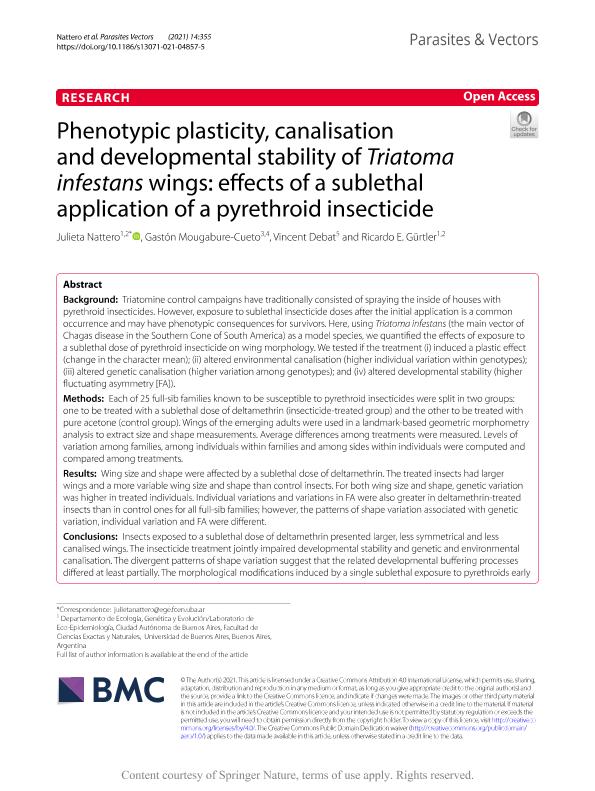Artículo
Phenotypic plasticity, canalisation and developmental stability of Triatoma infestans wings: effects of a sublethal application of a pyrethroid insecticide
Fecha de publicación:
06/12/2021
Editorial:
BioMed Central
Revista:
Parasites and Vectors
ISSN:
1756-3305
Idioma:
Inglés
Tipo de recurso:
Artículo publicado
Clasificación temática:
Resumen
Background: Triatomine control campaigns have traditionally consisted of spraying the inside of houses with pyrethroid insecticides. However, exposure to sublethal insecticide doses after the initial application is a common occurrence and may have phenotypic consequences for survivors. Here, using Triatoma infestans (the main vector of Chagas disease in the Southern Cone of South America) as a model species, we quantified the effects of exposure to a sublethal dose of pyrethroid insecticide on wing morphology. We tested if the treatment (i) induced a plastic effect (change in the character mean); (ii) altered environmental canalisation (higher individual variation within genotypes); (iii) altered genetic canalisation (higher variation among genotypes); and (iv) altered developmental stability (higher fluctuating asymmetry [FA]). Methods: Each of 25 full-sib families known to be susceptible to pyrethroid insecticides were split in two groups: one to be treated with a sublethal dose of deltamethrin (insecticide-treated group) and the other to be treated with pure acetone (control group). Wings of the emerging adults were used in a landmark-based geometric morphometry analysis to extract size and shape measurements. Average differences among treatments were measured. Levels of variation among families, among individuals within families and among sides within individuals were computed and compared among treatments. Results: Wing size and shape were affected by a sublethal dose of deltamethrin. The treated insects had larger wings and a more variable wing size and shape than control insects. For both wing size and shape, genetic variation was higher in treated individuals. Individual variations and variations in FA were also greater in deltamethrin-treated insects than in control ones for all full-sib families; however, the patterns of shape variation associated with genetic variation, individual variation and FA were different. Conclusions: Insects exposed to a sublethal dose of deltamethrin presented larger, less symmetrical and less canalised wings. The insecticide treatment jointly impaired developmental stability and genetic and environmental canalisation. The divergent patterns of shape variation suggest that the related developmental buffering processes differed at least partially. The morphological modifications induced by a single sublethal exposure to pyrethroids early in life may impinge on subsequent flight performance and consequently affect the dynamics of house invasion and reinfestation, and the effectiveness of triatomine control operations. Graphical Abstract: [Figure not available: see fulltext.].
Archivos asociados
Licencia
Identificadores
Colecciones
Articulos(CCT - CORDOBA)
Articulos de CTRO.CIENTIFICO TECNOL.CONICET - CORDOBA
Articulos de CTRO.CIENTIFICO TECNOL.CONICET - CORDOBA
Articulos(IEGEBA)
Articulos de INSTITUTO DE ECOLOGIA, GENETICA Y EVOLUCION DE BS. AS
Articulos de INSTITUTO DE ECOLOGIA, GENETICA Y EVOLUCION DE BS. AS
Citación
Nattero, Julieta; Mougabure Cueto, Gastón Adolfo; Debat, Vincent; Gurtler, Ricardo Esteban; Phenotypic plasticity, canalisation and developmental stability of Triatoma infestans wings: effects of a sublethal application of a pyrethroid insecticide; BioMed Central; Parasites and Vectors; 14; 1; 6-12-2021; 1-12
Compartir
Altmétricas




